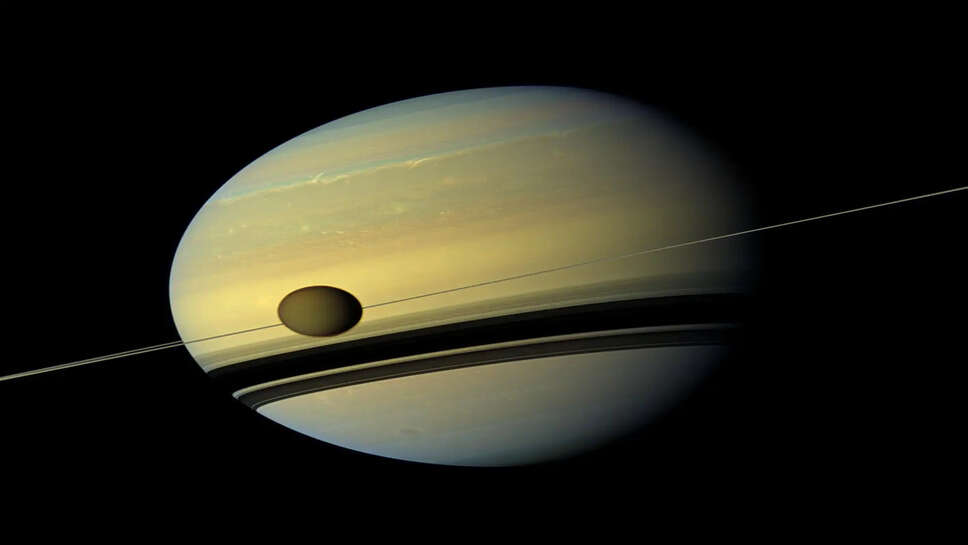Titan’s Methane Ocean: A Cosmic Mystery on Saturn’s Moon

When we think of oceans, images of vast stretches of water often come to mind, perhaps even the majestic oceans of Earth. But on Saturn’s moon Titan, the concept of an ocean takes on a strange twist—this moon harbors not an ocean of water, but one of methane and ethane, two hydrocarbons that are typically found as gases on Earth. Titan, the second-largest moon in our solar system, is home to what may be the most exotic liquid seas in the universe. Let’s take a deep dive into this celestial wonder and explore what makes Titan's methane oceans so fascinating.
Titan’s Methane Seas
Titan, unlike Earth, has an atmosphere that is thick with nitrogen and methane, creating an environment unlike anything we experience here. Beneath the dense, hazy atmosphere, scientists have found a rich and complex landscape that includes not only lakes and rivers, but large oceans of liquid methane and ethane. These oceans are believed to be at least 200 meters deep in some places, and their size rivals the Great Lakes of Earth.
The liquid methane on Titan is able to exist as a stable, non-gaseous form due to the extremely cold temperatures on the moon, which hover around -290°F (-179°C). This subzero environment allows methane, which on Earth would evaporate, to pool into lakes and seas, creating a remarkable and unfamiliar type of landscape that seems to mimic some of the conditions of Earth’s water-based features.
The Methane Cycle: A Titanic “Water Cycle”
Just as Earth has a water cycle—evaporation, condensation, and precipitation—Titan has its own unique version of a “methane cycle.” On Titan, the methane in the atmosphere undergoes a cycle very similar to how water behaves on Earth. Methane in Titan’s atmosphere condenses into clouds, which then precipitate as liquid methane, falling to the surface where it accumulates in lakes and seas. Over time, this methane evaporates, replenishing the atmosphere, and the process begins again.
However, the methane cycle on Titan has a crucial difference from Earth's water cycle: the lack of liquid water. As a result, methane on Titan behaves differently, particularly when it comes to erosion and surface features. The Titanian “rivers” flow with methane, creating winding channels, deltas, and even seasonal changes in the landscape.
Why Methane Oceans Are Fascinating
The discovery of methane oceans on Titan is not only intriguing because of the moon’s unusual landscape, but because it raises intriguing questions about the potential for life elsewhere in the universe. On Earth, life as we know it is fundamentally tied to water, and liquid water is considered a key ingredient for sustaining life. Titan’s methane oceans, while composed of a substance far more frigid and alien to us, present a tantalizing mystery for scientists who speculate about the possibilities of life that might arise under such extreme conditions.
One of the most exciting aspects of Titan’s methane oceans is that they are chemically rich. The methane could serve as a potential energy source, and some researchers have proposed that life—if it exists—could rely on methane and other organic compounds instead of water for metabolic processes. Though the temperatures are incredibly cold for Earth-like life to exist, there is still a lot of potential for exotic forms of life to thrive, should they find a way to adapt to these conditions.
How Scientists Study Titan’s Oceans
Exploring Titan's methane oceans is a difficult challenge due to the moon’s distance from Earth and the lack of direct human exploration. However, the Cassini-Huygens mission, which launched in 1997 and reached Saturn in 2004, provided us with an incredible wealth of data about Titan. The Cassini spacecraft, equipped with specialized instruments, was able to map the surface of Titan, take high-resolution images, and study the moon's atmosphere in great detail. Cassini’s flybys of Titan revealed information about its lakes, seas, and other surface features, including their chemical composition.
The Huygens probe, part of the same mission, landed on Titan’s surface in 2005 and provided direct observations of its surface, including detecting the presence of methane and other hydrocarbons. Although Huygens’ descent was brief, it offered a valuable first look at Titan’s environment and surface conditions.
What Lies Beneath Titan’s Methane Oceans?
Beyond the methane oceans themselves, there is also the tantalizing possibility that beneath the icy crust of Titan, there may exist liquid water oceans—something that could have important implications for the search for extraterrestrial life. While Titan’s surface is an inhospitable, frozen desert of methane, scientists believe that the moon may have a subsurface ocean of liquid water beneath its icy shell.
Researchers have hypothesized that Titan’s internal heat, generated by tidal forces from Saturn's gravity, could create a subsurface ocean of liquid water, which might be in contact with the moon’s rocky core. This water could, in theory, provide a more familiar and habitable environment for life. The presence of water, along with the potential for complex organic chemistry, makes Titan one of the most intriguing moons in the solar system when considering the possibilities for extraterrestrial life.
Future Exploration: Titan as a Prime Target for Study
The next steps in exploring Titan are set to be even more groundbreaking. NASA’s Dragonfly mission, scheduled to launch in the 2030s, aims to explore Titan's surface with a rotorcraft. The Dragonfly drone will fly to various locations on Titan, sampling materials and studying the complex chemistry of Titan’s atmosphere and surface. By traveling to different regions of Titan, Dragonfly will help scientists understand the nature of its lakes and seas, as well as the potential for life to survive in such an environment.
The Dragonfly mission will also focus on the moon’s methane cycle and whether there are any hints of biological processes that could be occurring within Titan’s oceans. Dragonfly’s exploration could answer some of the most profound questions we have about Titan: Could life exist there? If so, what would that life look like?
Titan’s Oceans: A Peek Into Alien Worlds
Titan’s methane oceans are one of the most mind-bending and exciting discoveries in space exploration. They present us with a landscape that is both alien and familiar, resembling the conditions of Earth in some ways, but so different in others. Titan is a laboratory for studying how life might arise and adapt in environments that are vastly different from what we know. The fact that liquid methane exists on its surface challenges everything we understand about the nature of oceans, weather systems, and even the potential for life in the universe.
As we continue to explore Titan and other distant worlds, we may uncover answers to questions about life beyond Earth and the possibilities for life in our solar system and beyond. Titan’s methane seas remind us that even in the coldest, most hostile environments, there may be more than meets the eye. And who knows—perhaps the discovery of life in Titan's methane oceans will be just the beginning of our quest to understand the true diversity of life in the cosmos.
